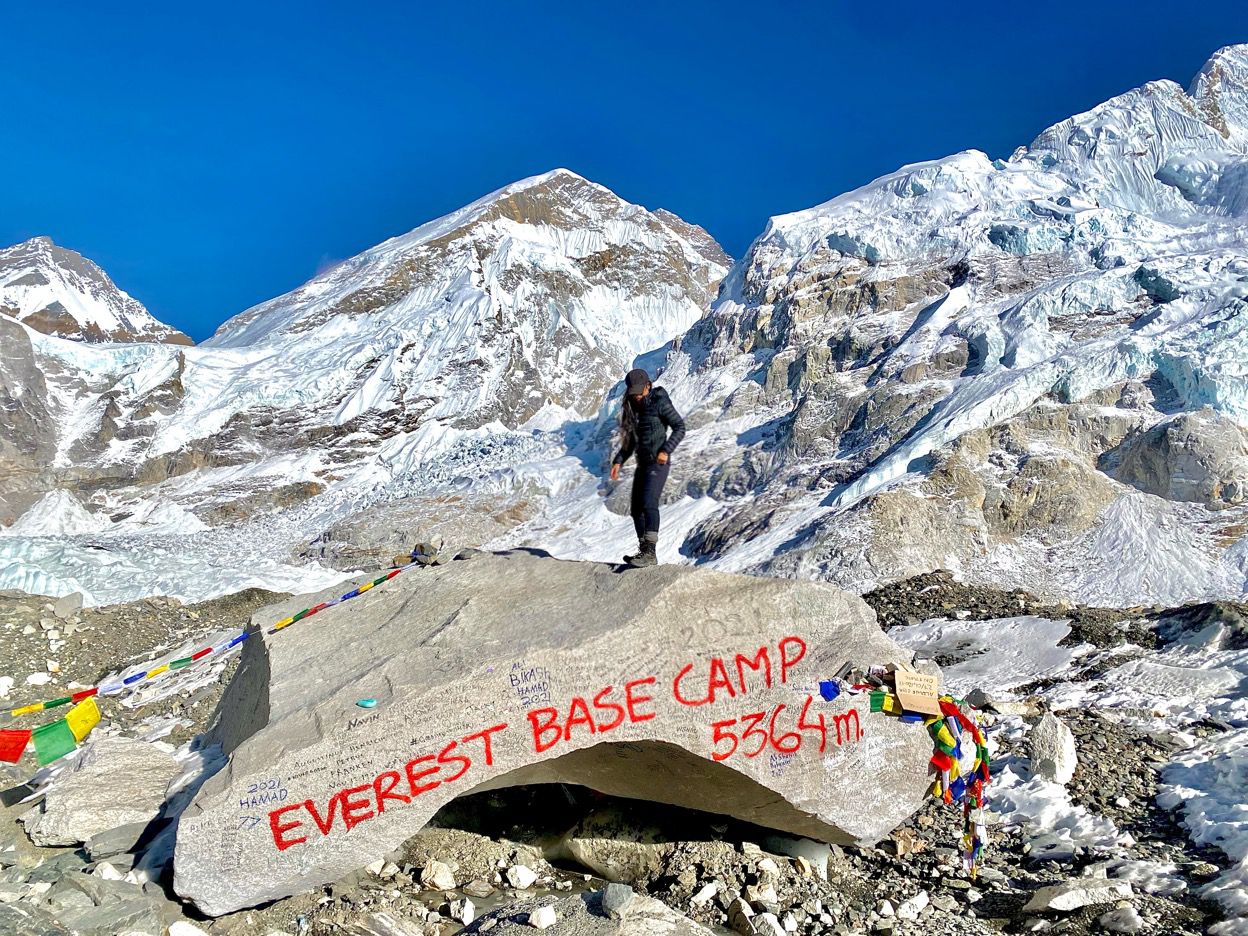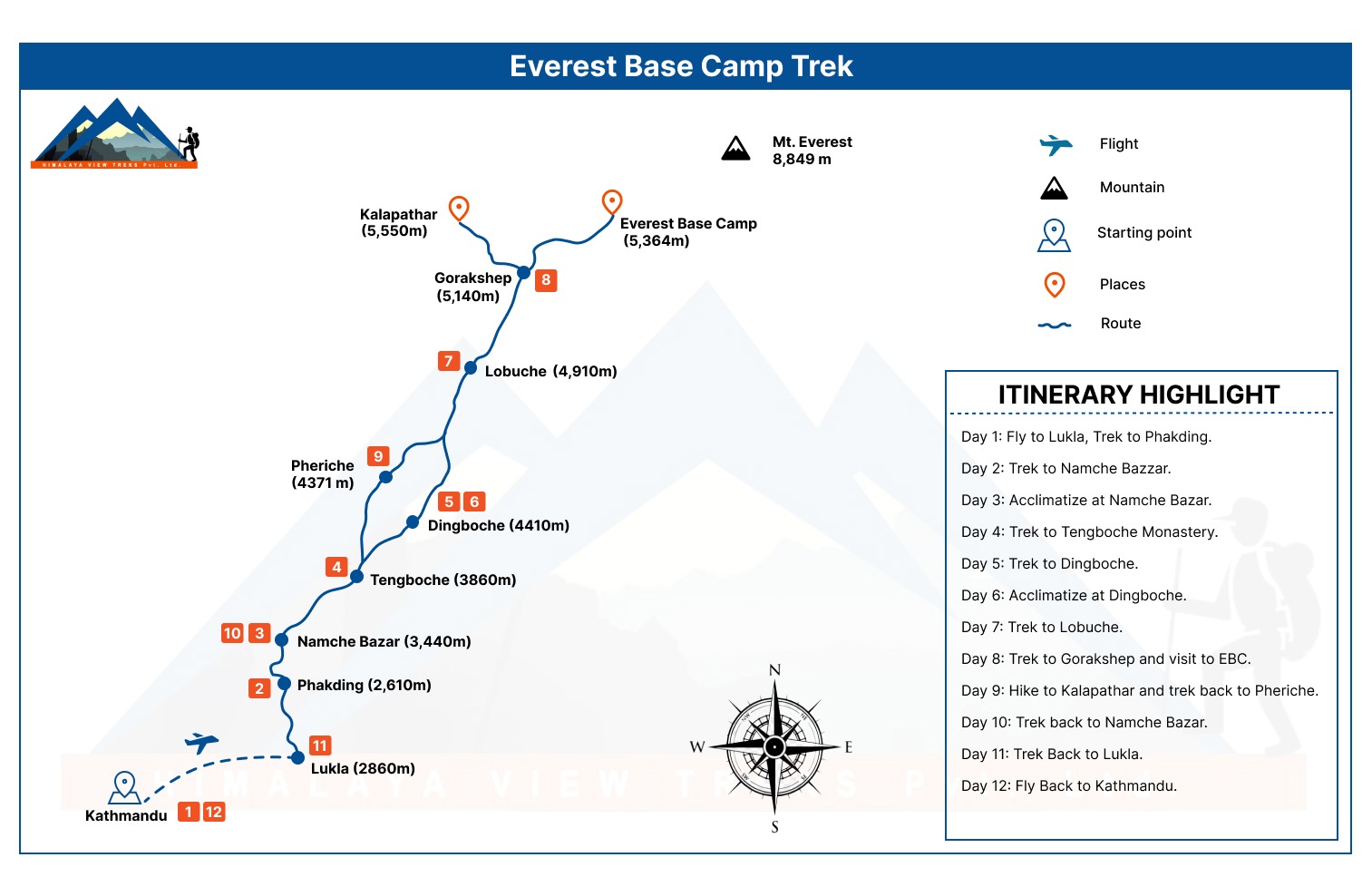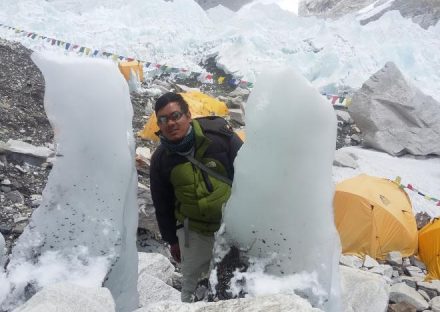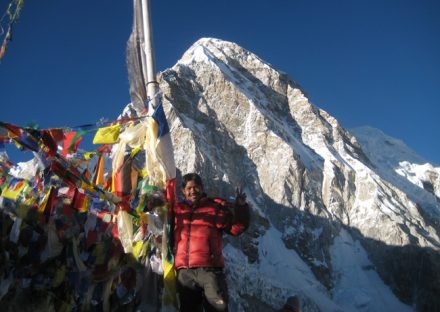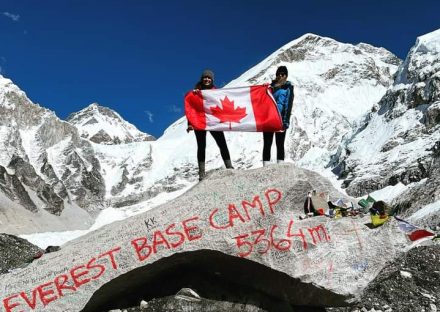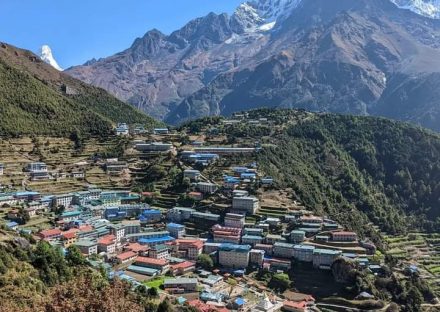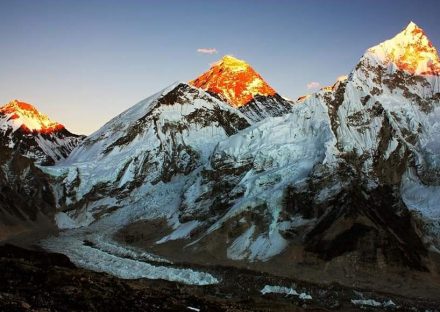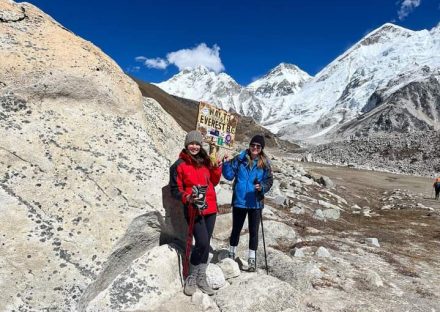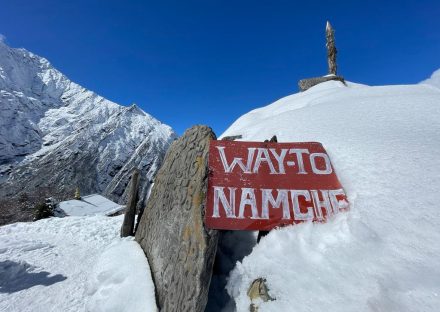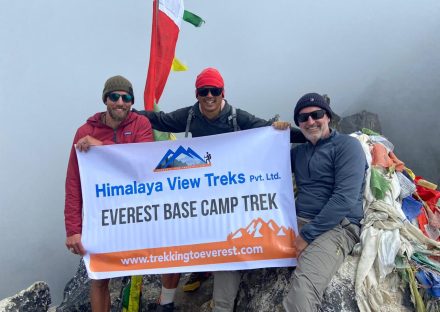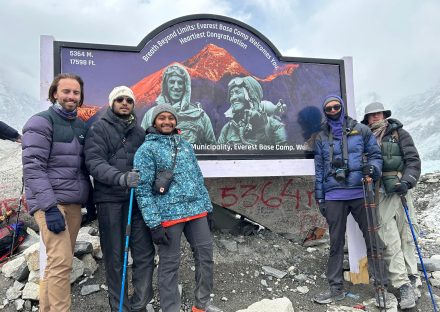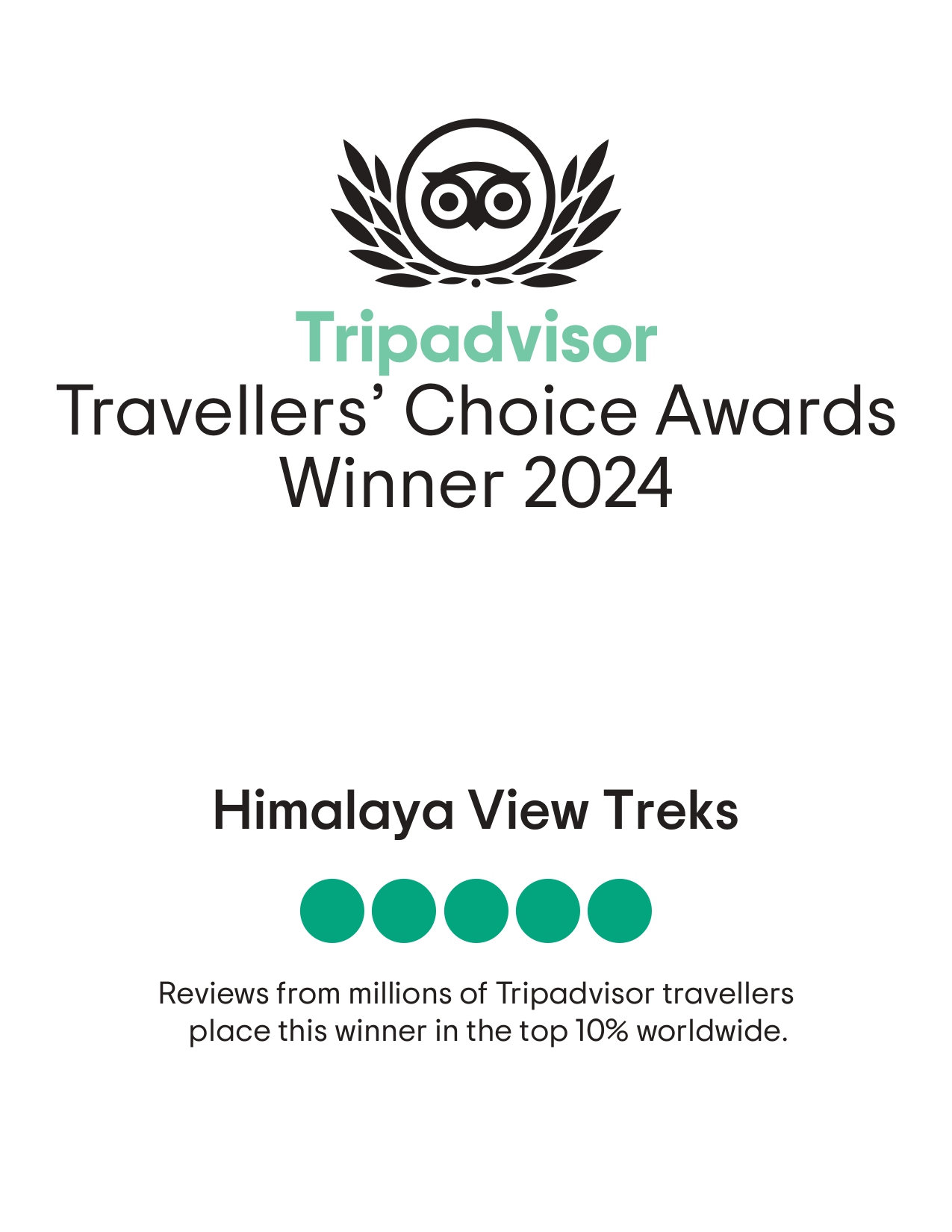- Details
- Short Itinerary
Detailed itinerary
Itinerary- Tour Includes/Excludes
- Cost and Dates
- Useful Info
- Map
- Photos
- FAQ
Trip overview
Everest Base Camp Trek – 12 Days
The 12-day Everest base camp trek with Himalaya View Treks trip route Itinerary gives you the feel of a legend close to Sir Edmund Hillary. The sky above the earth below. Hiking the trails & peace within. This is what (5364m.) the Everest base camp trek is all about…
The journey of Everest Base Camp in Nepal never fails to provide splendid walking holiday experiences. It is the destination where one can knit a Himalayan wilderness experience in the lap of the world’s tallest mountain Mt. Everest. Himalaya View Treks is a reliable trekking agency that operates trekking trips by experts and highly experienced Local Sherpa guides and Strong Porters.
Why must you do the Everest Base Camp (EBC) Trek?
5 reason of to do Everest trek, Nepal Mount Everest base camp path is said to be the king of all walkers’ holidays on earth. In other words, doing EBC is similar to a feat once done by a legendary mountain climber, Sir Edmund Hillary. Your average cost of EBC Nepal treks is so much more worth the trip—5364 m. The Everest base camp trek 12-day trip Itinerary offers adventure lovers worldwide a chance to reach the Base of Everest comfortably. Our way of operating trekking tours will help both novice and veteran trekkers. Himalaya View Treks employ a scientific itinerary-making method so that all age group of people can fulfill their dream of leaving footprints at Everest Base Camp. plan your next study once a lifetime experience.
HIMALAYA VIEW TREKS Everest base camp trek altitude in Nepal allows better acclimatization to help you feel good. This is the key to any successful trekking in the Everest region. Moreover, you can chat and learn about the brave Sherpa people & their lifestyles. Our trail goes through the famous villages of Namche and Khumjung. Furthermore, visiting the Tyangboche monastery also echoes the famous Sherpa culture. Gorakshep is the last camp of the 12-day Everest Base Camp trek , and elevation of Gorakshep is 5160m from sea level. From Gorakshep, you can hike to Kalapatthar at 5545m. and Everest Base Camp at 5364m. in same day.
Journey to Sherpa Kingdom Khumbu, Base of Mt. Everest, Incredible eye catching view of Mount Everest from Kala Patthar
The Kala Patthar is the Highest point of 12 days Everest Base Camp Trek, Elevation of Kala Patthar is 5545m. You will able to see closer and Incredible eye catching views of Mt. Everest top and surrounding peaks from Kalapatthar. And, Everest base camp (EBC) is 5364m. from the sea level. However, the Wonderful Journey to Everest base Camp in Pasang Lhamu rural Municipality of the Sherpa Kingdom Khumbu Nepal includes ascents to Kala Patthar peak at (5545m), via Khumbu Glacier an important highlight of the 12-day EBC route.
For instance, you will see some world-famous peaks from the breathtaking point. These peaks include Mt. Lhotse Nuptse, Pumori, Thamserku, Everest south Col, Amadablam & Mount Everest, from a real close-up. Likewise, we also get to view classic climbing routes to the summit of Mount Everest. Further on the cards is a hike to Everest Base Camp from where expeditions prepare to climb the world’s highest peak.
Similarly, the best is yet to come. We enjoy stunning sunrise and sunset views over grand peaks, causing our hearts to dance with emotions. These are some major highlights of our EBC Trip of 12 days. Although, HVT Everest base camp trekking itinerary gives you some of the best experiences, ever.
Get ready to write a legendary travel story about your journey in Nepal. Share it with your loved ones when you return Trek from Everest Base Camp.
Moreover, the Superb Trek to Everest Base Camp journey begins with a short flight to Lukla airport from Kathmandu, a lovely Sherpa Kingdom of Khumbu Valley. After landing at Lukla, trekkers will meet the rest of the crew members. The route passes through the little town of Phakding to reach the Khumbu capital of Namche Bazaar. From here on, we enter the striking Sagarmatha National Park Entry Point (the World’s highest national park). We do a steep hike up to the Everest View Hotel to acclimatize. From the vantage point of this popular hotel, we get our first views of some of the highest peaks on earth. the best time of the year, Spring season Mar / April / May and Autumn season Sep/ Oct / Nov.
At the end of it all, Himalaya View Treks Everest Base Camp trip package concludes after we reach the peak of Kalapathar at 5545m. We then trace our steps back to Namche Bazaar for a deserving restful night. The next morning we walk down to Lukla for our flight back to Kathmandu.
Short Itinerary
Everest Base Camp Trek Itinerary - 12 Days
Day 01 Fly to Lukla and then trek to Phakding walking distance of 6.2 km (3-4 Hours) 2,860 meters/9184ft
Day 02: Phakding to Namche Bazaar walking distance is 7.4 km (5-6 Hours) 3,440m/11,283ft
Day 03: Acclimatization Day, Hike to Everest View Hotel 3880m/13000ft, and then back to Namche
Day 04: Namche to Tengboche walking distance 5.9 km (6 hours) 3,870m/12,684ft
Day 05: Tengboche to Dingboche walking Distance 9.1km (6 hours) 4,400m/14,435ft
Day 06 Dingboche Acclimatization Day, climbing the (5100 m) hill of Nagarshan (2/3 Hours) 4,400m/14,435ft and then back to Hotel
Day 07: Dingboche to Lobuche Walking distance 10 km (6-7 hours) 4,900m/16,076ft
Day 08: Lobuche to Gorakshep 4 km (6-8 hours) 5180m/16,994ft (Gorekshep) and then hiking Everest base camp 5364m/17598 Via Khumbu Glacier)
Day 09: Hike to Kalapatthar and then trek back to Pheriche walking distance 9.8 km (5-6 hours)5,545m/18,192ft (Kalapathar) & 4,320m/14,173ft (Pheriche)
Day 10: Pheriche to Namche Walking Distance 14.2 km (5-6 hours) 3440m/11285ft
Day 11: Namche to Lukla Walking Distance 13.5 km (5-6 hours) 2,800 m 9,100 ft
Day 12: We will fly back from Lukla to Kathmandu (1300 m). 30 minutes.
Detailed Itinerary
Day 01: Fly to Lukla and trek to Phakding
Early in the morning we will gear up for the flight to the world’s most extreme airport, the Lukla Tenzing Hillary Airport. From this place we will commence our trekking. We will walk towards Phakding which is at the 2610 m from sea level. The trail is easy and gentle with 2 suspension bridge and many Mani walls along the way. Phakding is located on the bank of Dudhkoshi River. Overnight at teahouse, Refresh and dinner- Lukla to Phakding walking distance 6.2 km (3-4 Hours) 2,860 meter/9184ft
Day 02: Journey to Namche Bazzar
Today is the day we enter the Sagarmatha National Park. Moreover, today we will be crossing at least 5 suspension bridges along the way including famous Hillary Twin Bridge at the foothill of Namche Bazaar Hill. We will be able to see the first view of Mt. Everest from Top Danda which is few meters away from Namche Bazaar. Remember that it is dependent upon the weather conditions. Stroll around the marketplace in the evening. The best view of Thamserku and Kwangde Ri is possible to capture from Namche Bazaar. Stay overnight at our teahouse. Refresh and dinner -Phakding to Namche walking distance is 7.4 km (5-6 Hours) 3,440m/11,283ft
Day 03: Namche bazzar acclimatize day, hike to Everest View Hotel
Today is the day of acclimatization. It is necessary to do the proper acclimatization activities during Everest or any kinds of high altitude trekking. We will trek to the world’s highest situated Himalayan belt hotel the Everest View Hotel as part of our acclimatization exercise. If time permit we will also visit the mountain museum located at the top of Namche Bazaar hill. The mountain vista of Amadablam, Thamserku, Tabuche, Nuptse, Lhotse and Everest make your acclimatization exercise overwhelming. In the evening, we can visit the marketplace of Namche Bazaar. There are numerous eateries, bars, shops, banks and teahouses in the area. The guide will decide whether to include the Sherpa Village of Khumjung Including Hillary School and Hillary Hospital or Khunde in your acclimatization exercise. It depends upon your physical status. Please consult and heed the instructions of the guide. Stay overnight at our same teahouse lodge. Refresh and dinner - 3 Hours 3,440m/11,283ft
Day 04: Trek to Tengboche Monastery
Today’s trekking is interesting. We will be trekking uphill from the teahouse/lodge in Namche Bazaar to the top of the hill and start the trekking to Kyagjuma on the Nepalese Flat terrain. From Kyangjuma we will trek downhill to Phungi Thanga where we will take the lunch break too. From this place, after crossing the suspension bridge we will have to walk through green lush forests towards Tengboche. In the evening we will visit the monastery and learn about the local religious practices as well as the rituals. However, it is dependent, the monastery opens only during favorable times. Refresh and dinner- Tengboche from Namche walking distance 5.9km (6 hours) 3,870m/12,684ft
Day 05: Trek to Dingboche via Dibuche, Somare
Early in the morning we will start our trek after breakfast. First, we will have trek through debuche which is at the foothill of Tengboche on the bank of Imja Tse River. We will explore through the Pangboche Village towards Dingboche. The normal lunch break is at either Pangboche or Somare. The terrain beyond Pangboche has the less vegetation. Therefore, trekkers need to be extra careful during this section of the trip. Tengboche to Dingboche walking Distance 9.1km (6 hours) 4,400m/14,435ft
Day 06: Acclimatization day at Dingboche
Today is the second acclimatization break during the trekking. It is utmost necessary to do the acclimatization exercise. High altitude trekking success depends upon the exquisite planning and expert trekking advice. Therefore, climbing the 5100 m hill of Nagarshan helps in adjusting to the higher altitude. After the hike, we return back to Dingboche overnight at our teahouse lodge. Refresh and dinner 2/3 Hours 4,400m/14,435ft
Day 07: Trekking to Lobuche
After breakfast we will start our trekking towards Lobuche. The vegetation is very scattered on this section of the trekking. Trekkers have to walk on the ridge line overlooking Pumori and Cholatse. The sight of the Pheriche Village on your left and the Nagarshan Hill on the right side enthralls the trekking. We will have the lunch at Dugla. We will have to walk uphill to cross the Dugla Pass to reach Lobuche.
We will pay our respect to the memorial of climbers who lost their lives during Everest Expedition at the Dugla Pass. The time spent in Lobuche is mystical as the place is on the bank of river overlooking Mt. Pumori, Lobuche and the Kong Ma la Pass. Refresh and dinner-- Lobuche from Dingboche Walking distance 6.6 km (6-7 hours) 4,900m/16,076ft
Day 08: Trek to Gorakshep and afternoon visit to Everest Base Camp
Early in the morning after breakfast we will have to walk towards Everest Base Camp. Today is the most exciting day of our trekking. We will visit the Everest Base Camp. The trail is rugged and on the moraine. Once we reach the Gorakshep we will have our lunch. After lunch we will continue our hike to Everest Base Camp. It takes about 1.5 hours to reach the base camp from Gorakshep. We will take as many pictures as possible in the base camp. Remember that we will not see the Mt. Everest from the designated base camp. However, it is possible to see the top of Mt. Everest few meters before reaching base camp. We will again return back to Gorakshep. Refresh and dinner ( walking distance 4 km (6-8 hours) 5180m/16,994ft (Gorekshep) & 5364m/17598 Everest Base Camp)
Day 09: Hike to Kalapathar and trek back to Pheriche
Be ready for the hectic day of trekking. Early in the morning around 4:30 am we will hike to the top of Kalapthar (5545 m). This is the best place to witness sunrise and Mt. Everest Vista. After such an amazing experience we will return back to Gorakshep for the breakfast. After breakfast we will retrace the trek trail back to Pheriche via Lobuche and Dugla. Refresh and dinner -Kalapatthar to Pheriche walking distance 9.8km (5-6 hours)5,545m/18,192ft (Kalapathar) & 4,320m/14,173ft (Pheriche)
Day 10: Trek back to Namche Bazar
The return trip during Everest or any high altitude trekking in Nepal is amazing. This is because of the decreasing altitude. Therefore, lots of people consider the return trip as the most joyous time of trekking. Enjoy your return trip. Your body will also support you and the scenery is outstanding as always. Overnight at our teahouse lodge, Refresh and dinner, Pheriche to Namche Walking Distance 14.2 km (5-6 hours) 3440m/11285ft
Day 11: Trek back to Lukla
We will trek back to Lukla on this day. The trail is the same. However, you will be able to witness lot more new things during the return trip. It is because; you have already completed the base camp journey. By this time you would have already been adjusted to the high altitude. Therefore, talk to the locals and understand the daily lives of the people in the trail. Once you reach Lukla, arrange the celebration. Today is the last day of the trekking. Therefore, celebrate with your guide and porter. Overnight at our teahouse lodge refresh and dinner, Namche to Lukla Walking Distance 13.5 km (5-6 hours) 2,800 m 9,100 ft
Day 12: Fly back to Kathmandu from Lukla
We will fly from Lukla to Kathmandu (1300 m). We wake up early for our flight back to Kathmandu. We say goodbye to the serene and magnificent mountains and board the flight to come back to the city civilization. The rest of the afternoon in Kathmandu will be at leisure. Walking around the streets of Kathmandu; souvenir shopping; finding a massage or relaxing at the hotel can be easy ways to spend time.
Included
- Airport pickup and drop as per the client’s arrival and departure time
- Hotel- domestic airport- hotel by car/ van, depending on group sizes
- Domestic flights (Kathmandu - Lukla - Kathmandu) tickets including airport taxes
- All meals (Breakfast, lunch, and dinner) during your Everest base camp Trek
- 11 nights of Hotel Accommodation during the EBC Trek
- Government licensed holder, fluent English Speaking, Familiar HVT Leader guide
- One assistant guide if the Group size is more than 10 trekkers)
- Strong local Porters for Carry trekker’s luggage one porter every 2 trekkers, Note- Porter not includes for Single client.
- Guide and porter wages including their meals, accommodation, and Salary
- Staff insurance including medication coverage
- Guide and Assistance both ways Lukla flight Ticket
- Equipment for the Company staff
- Water purification drops or tablets for safe drinking water
- Sagarmatha National Park entry permit fee
- Khumbu Pasang Lhamu Rural Municipality Permit fees
- Trekker’s information management system (TIM’s card)
- Seasonal fresh fruits every day during your Everest Base Camp trek
- Oximeter to measure Pulse and oxygen level
- Company T-shirt as a Souvenirs, and duffel bag if needed
- Local government, taxes, including official Service Charge
- Trip completion Certificate
Not Included
- Hotel accommodation and meals In Kathmandu
- Personal expenses (shopping, snacks, boil bottled water, hot (tea, coffee) and cold drinks, hot shower, alcohol, Wi-Fi, telephone call, battery charge fee during the Everest base camp Trek)
- Personal clothing and trekking gear
- Sleeping bag and down jacket available for rent in our store
- Personal travel insurance including evacuation coverage (compulsory) up to 6000m)
- Additional costs if delays flights and outside the itinerary
- Porter if you are single
- Tips for Guide and Porters at the end of the treks
Join Us Upcoming Trips
Book this trip with us. Here are the upcoming dates. Feel free to share this trip with your friends and family. For custom trips or general inquiries contact us.
| Departure Date | Trip Duration | Price | Status | |
|---|---|---|---|---|
| 07 September, 2025 | 12 Days | US$ 1245 | Available | |
| 09 September, 2025 | 12 Days | US$ 1245 | Available | |
| 13 September, 2025 | 12 Days | US$ 1245 | Available | |
| 19 September, 2025 | 12 Days | US$ 1245 | Available | |
| 21 September, 2025 | 12 Days | US$ 1245 | Available | |
| 23 September, 2025 | 12 Days | US$ 1245 | Available | |
| 02 October, 2025 | 12 Days | US$ 1245 | Available | |
| 03 October, 2025 | 12 Days | US$ 1245 | Available | |
| 05 October, 2025 | 12 Days | US$ 1245 | Available | |
| 13 October, 2025 | 12 Days | US$ 1245 | Available | |
| 15 October, 2025 | 12 Days | US$ 1245 | Available | |
| 17 October, 2025 | 12 Days | US$ 1245 | Available | |
| 24 October, 2025 | 12 Days | US$ 1245 | Available | |
| 27 October, 2025 | 12 Days | US$ 1245 | Available | |
| 29 October, 2025 | 12 Days | US$ 1245 | Available | |
| 07 November, 2025 | 12 Days | US$ 1245 | Available | |
| 09 November, 2025 | 12 Days | US$ 1245 | Available | |
| 11 November, 2025 | 12 Days | US$ 1245 | Available | |
| 17 November, 2025 | 12 Days | US$ 1245 | Available | |
| 19 November, 2025 | 12 Days | US$ 1245 | Available | |
| 21 November, 2025 | 12 Days | US$ 1245 | Available | |
| 25 December, 2025 | 12 Days | US$ 1245 | Available | |
| 27 November, 2025 | 12 Days | US$ 1245 | Available |
Useful Info
Everest Base Camp Trek ( EBC ) Key Highlights:
- Trek to the iconic Everest Base Camp 5364m. with support from our experienced team of local guides, crew, and porters who simply love what they do.
- Climb Kalapathar (5545m) for grandstand Eye catching views of Mt. Everest, 8848m. Lhotse, Nuptse, and surrounding peaks. The sights here are some of the best in the world.
- Experience the breathtaking mountain flight to Tenjing Hilary Airport Lukla, you’ll love it. 138Km, flight duration 30 to 40 minutes. from Kathmandu.
- Immerse yourself in colorful ancient Kathmandu with an optional s/seeing
- Biggest Monastery, Tengboche Monastery 3867m. from the sea level
- Highest Hotel in the world at Gorakshep 5,164 m.( 16,942Feet)
- Everest Highest Bungee From Hillary suspension Bridge
- Old Sherpa Village Khumjung, Visit the Khumjung monastery you will able to see Yeti Skull
- ( Sherpa Museum in Namche Bazar) history of Sherpa and photography collection of Mount Everest summiteers.
- 17 Kilometers long Khumbu Glacier and chance to see live Khumbu Icefall
- expedience the New Everest Base camp and Old Base camp at same time.
- Experience the warmth and hospitality of the Local Sherpa people. Interact with them to learn of their lifestyles & traditions as they survive in harsh conditions for all of their lives.
- Trek distance, Lukla to Everest base Camp to Lukla Both Ways, walking distance 130 Km. Approximately 8 to 11 Days
Is Everest Base Camp Trek your ideal?
Trekking in the Everest region is all about attitude. By its very nature adventure travel involves that you be prepared for the unexpected. In far-flung and developing countries do not expect the standards you are used to at home. Remote areas are sometimes unpredictable and itineraries may be altered. To enjoy your trip and get the most out of your adventure you must be flexible, positive, and eager to take on all the challenges that arise from your Everest base camp odyssey. If you’re a greenhorn in the wilderness world then this trek would be ideal for you.
To truly enjoy this trip, you should be pretty habituated to walking 4-6 hours each day for several days on the go while some days will be relatively longer. We encourage you to walk at a pace that suits you without any rush whatsoever. This is a key aspect of enjoying such trips in the planet’s most popular region. You ought to be physically fit and an active walker to get the best of this classic mountainous journey to the south side of the mighty Everest.
General information important to this trip:
Difficulty levels
TREKKING AT HIGH ALTITUDES (over 3500m)
This trip includes strenuous trekking at altitudes of over 3500m. For us, altitude is a very serious issue, a result that has kept our records clean making us one of the best adventure operators in Nepal for over 30 years of operating treks in the region. Our trekking guests must be in excellent health and have high fitness levels to attempt this trip, as well as be committed to training to ensure you are suitably physically prepared for the tough challenges that go above 4500m.
Altitude sickness is a risk for anyone, including on the Annapurna, Langtang, and Everest Base Camp treks. Please make sure you familiarize yourself with signs and symptoms before you depart and monitor your health during your trek, without letting it worry you.
We advise all our guests to undergo a thorough medical with their physician before they embark on this trip.
Participating in a group trip
When you travel with a group you will find much camaraderie and all the fun and also there’s bound to be some of the frustrations of traveling in a group. Your group mates will probably come from all corners of the world and you will come across a range of age groups too. We ask you to be understanding of the various needs and preferences of your group - patience with your fellow travelers is sometimes required for the benefit of everyone's travel experience. Remember too that you have responsibilities to the group. If you are requested to be at a place at a certain time, ensure you’re on time without keeping the rest of the group waiting. Experience has taught us often that the very best trips we operate are those where the chemistry within the group works well - this requires a ‘give a little take a little’ attitude effort on your part. For privacy reasons, we are unable to provide you with contact details and any personal information about your fellow travelers booked on your trip before departure.
TRAVELERS who prefer going SOLO:
Our group trips are generally planned for shared accommodation and don't involve single supplements. Single travelers share with people of the same gender in accommodations ranging from twin to multi-share. Some of our itineraries have accommodation booked on a mixed-gender share basis [for couples or trekkers known to each other before the trip]. On a selection of our trips, you have the option to pay a single supplement to ensure that you have your accommodation (where available). Please note that this only applies to accommodation during the trek - pre-trip and post-trip accommodation will be booked on a single-room basis at your hotel in Kathmandu. We also have arrangements for guests who wish to trek completely solo out of the group.
Travel Insurance
when booking with Himalaya View Treks, it’s a condition upon joining any of our trips that all clients must be insured for comprehensive expenses that might incur due to medical issues or accidents (this includes air ambulance, helicopter rescue, and treatment costs). Please note that we don't arrange or sell insurance because such a system is not allowed in our country.
Our Cost versus the Experience
At Himalaya View Treks, we always go the mile to ensure our trekking guests get the best experiences of the trip with maximum comfort and safety on a ratio that goes beyond the cost that we charge for the trip. We provide a ‘no frills’ price with breakdowns to make sure our clients are getting the best for a cost that goes beyond all expectations
Tipping [an expectation on such risky arduous trips]
Tipping is very much part of the culture in Nepal and although entirely at your discretion, it is usually expected. Often people would like to tip in recognition of good service but are unsure how much would be appropriate in a foreign country - for this reason, we have listed guideline amounts below (these are intended as a guideline only and you may see fit to give more or less depending on the service that you have received).
For the tipping of your trek staff and your tour leader, we suggest passing an envelope for each staff member around the group so that everyone can put in what they feel comfortable with anonymously.
The following are guideline amounts received by each staff member from the group as a whole...
- Tour Leader: Rs30,000 - 35,000 (usually tipped on the last night in Kathmandu)
- Your trekking crew (tips are usually given on the last evening of the trek in Lukla):
- Head Trekking Guide and Assistant Guides: Rs 20,000 - 25,000 for each guide
- Trek Porters/yak men: Rs 10, 000 for each porter or yak man
Acute Mountain Sickness [AMS]
When we ascend above 2500 meters our bodies have to acclimatize to the decreasing amount of oxygen available. So, to allow our bodies to adjust we have designed our treks in ways that help you ascend slowly, allowing acclimatization to occur when you go above the tree lines where the air is thinner. However, during the acclimatization process, you may experience some of the following symptoms.
- Headache
- Tiredness
- Disturbed sleep patterns
- Loss of appetite/nausea
- Shortness of breath
- Cough
- Palpitation
- Swelling of the hands and face
But if you feel such symptoms don’t let it worry because it’s normal. Individuals acclimatize at different rates. Some may experience symptoms, some may not. Your best strategy is to take your time and drink plenty of water. These symptoms may not indicate the onset of A.M.S.; if you experience them, it does not necessarily mean that you should not continue. All our group leaders have extensive first-aid training and we urge you to communicate with the group leader at all times should you believe you have any symptoms so that we can effectively monitor your symptoms as you go higher. The only cure for Acute Mountain Sickness is to descend. Please note, that your group leader has ultimate responsibility and may ask you to descend if symptoms persist. As a last resort, if matters grow from bad to worse, we always have a helicopter on standby for immediate evacuation.
A Typical Day on the Everest Base Camp Journey
A typical day on the trail begins with a wake-up call at around 6 AM by your guide. Freshen up and get ready. Pack your belongings and head to the dining area for breakfast by 7 AM. Check your luggage for the final time and fill your water bottle before you hit the trail by 8 AM, along with your guide.
To avoid walking in the heat and enjoy clear mountain views, you make an early start. En route, there will be short breaks to enjoy the views and take photographs. You haul up for lunch at a local teahouse around noon or mid-day. After a quick rest of about an hour or 40 minutes, you get back on the trail and continue till you reach your overnight stop.
Upon reaching the stop for the night, you head to your tea house, check-in, and have some rest. Tea with some light refreshments (cookies or biscuits) will be served at 5 p.m. As the rooms are not insulated, you can warm yourself with the heater or stove in the communal area.
Exchange stories or play cards with other trekkers and Sherpas till dinner is served (around 7 PM). After dinner, your guide will brief you about the next day’s trek – the route you will take, the difficulties, where you will stop for lunch, etc. Afterward, retire for the night and have a well-deserved rest.
On average, you may have to walk 6 to 7 hours daily. The trek to Phakding is the shortest and the easiest, while the hike to Everest Base Camp from Lobuche on the 8th day could be your toughest. On Day 9, a hike to Kalapathar for the sunrise view is scheduled. So you will have to wake up before 4 AM to reach Kalapathar before sunrise. Your guide will share the details regarding the hike during the after-dinner briefing on Day 8.
Equipment for Everest Base Camp Trek
This section is intended to provide information on clothing and equipment requirements for Nepal Trek. It is not intended to be a final and authoritative checklist. For those who would like a more detailed discussion of these issues, we ask you to contact us at singbir@yahoo.com or via WhatsApp at +9779841146306
The following is a list of clothing and accessories that we recommend that you take with you. This is not intended to be a comprehensive clothing and equipment list, rather it is intended to act as a reminder of those items that we feel are essential for your comfort and convenience. However, we recommend that you may have your personal preferences for clothing which may be equally as suitable.
Footwear: Equipment List for EBC Trek
1. Walking boots with suitable ankle support that have been worn before the trek, and which are waterproof
2. Trainer or casual shoes, for trekking and/or traveling
3. Warm socks for colder areas
4. Gaiters, in case of rain or snow
Legwear
1. Loose, casual trousers for trekking
2. Thermal leggings for colder areas
3. Long skirt for women as an alternative to trousers
4. Waterproof trousers
Body
1. Selection of T-shirts, and long-sleeved shirts, preferably not cotton
2. Thermal shirt for colder areas
3. Warm shirt, possibly fleece, for colder areas
4. Fleece jacket or warm wool jumper
5. Windproof, waterproof outer shell garment for higher altitudes
6. Down jacket (optional for cold nights & mornings; can be hired in Kathmandu cheaply)
Head / Hands
1. Wool or fleece hat, or balaclava
2. Hat or cap for sun protection while trekking
3. Sunglasses or goggles
4. Warm gloves
Other Items
1. Strong rucksack or large hold all to be carried by porters
2. Day sack to be carried personally
3. Plastic bags or stuff sacks to store/separate trekking gear inside your main bag
4. One-liter water bottle
5. Personal first aid kit to include essential items
6. Sleeping bag, 4 season
7. Torch, ideally head torch
8. Camera and film! – For those not-to-be-forgotten shots of the Himalayas
9. Toilet items and towel
10. Large handkerchief/bandana for neck
Optional Items
1. Binoculars
2. Books (see Recommended Reading)
3. Altimeter
4. Compass
5. Playing cards/backgammon/chess set
And Finally
The most important things that you must take with you are a sense of humor, an open mind, and an understanding that a trip to Nepal is an adventure to a land that is very different from your own.
Everest Base Camp Entrance Permit Fee
Khumbu Pasang Lhamu Rural Municipality Fee US$30 per person
Sagarmatha National Park(Everest) – RS 3000 plus 13% VAT per person, if you are from SAARC country then RS 1500 plus 13% VAT
TIMS – US$ 20 per person if you are from a SAARC country then US$ 10
Things to Remember Before Trek to Everest Base Camp
There are a few things you must not miss out on before heading to Everest Base Camp. The journey is not ordinary and it is a high altitude zone. Therefore, you must prepare yourself for better results and successful completion of the trip. Here are a few things to remember before Everest Base Camp Trek.
-
- Travel Insurance: You must get travel insurance from your home country that covers emergency rescue by helicopter, medical expenses, accidents, etc. Give a copy of your insurance to our office so that in case of an emergency we can act swiftly.
- Physical Preparation: Prepare your body fully as you need to walk for more than 6 to 7 hours a day in high altitude and low oxygen level places. Moreover, it is effective when you have good stamina and mental fortitude. Start exercising at least one month before the trek. Your exercise routine must include cardiovascular exercises like running, swimming, walking, and cycling. These activities done regularly for about an hour for one month will immensely build your stamina.
- Permits: Ask for permits from the agency. You must attain Pasang Lhamu Rural Municipality permit and a Sagarmatha National Park permit to do this trek.
- Best Season: The best time to do an EBC Trek in Nepal is during the months of spring and autumn season. Make sure to book the trek for March, April, May, August, September, and October. It is possible to do the trek during monsoon, summer, and winter seasons too but the view is not great.
- Lukla Flights: Kathmandu to Lukla Flights during peak season is almost impossible. Therefore, to maintain traffic, the flight takes place from Ramechhap to Lukla. You need to take a jeep drive from Kathmandu to Ramechhap which takes about 4 to 5 hours. During normal times, the flight takes place from Kathmandu.
- Reserve Day: Always keep one extra day in your trip plan. The weather conditions of the Everest region are very unpredictable. Therefore, you shouldn't rush while doing this trek. Keeping a day extra will help you get rid of any kinds of stress.
- Food and Accommodation: Surprisingly, the Everest region of Nepal is well equipped with quality lodging and food. You can find any kind of cuisine (Chinese, Indian, Continental, and Local) in any restaurant along the trail. There are many luxury resorts too in the trail. So, there won't be any issue regarding the availability of lodging and food.
Are You Already in Nepal?
If you are already in Kathmandu or Pokhara Nepal and seeking to Hire a guide/porter or tour/trekking packages then you can directly contact an expert via WhatsApp at +9779841146306 Or visit our office:- Himalaya View Treks Kaldhara Marg, Kathmandu 44600, in front of the Kathmandu sport climbing center 1st-floor building.
FAQs
-
The weather forecast says rain/clouds/snow in Lukla on our Flight Day. Are we in for a rough flight?
When you are up on the mountains in Nepal, we would suggest you be ready for anything. You’re about to trek on some of the most rugged territory on earth, despite its extraordinary beauty. Weather forecasts for Lukla are never correct and different sources will give you different information. If it is a really bad day in terms of weather, the airlines will themselves cancel the flight and you might have to wait till the weather clears. Yes, flying in high altitude is never easy, even on a clear sunny day; the plane might face turbulence because of the wind blowing from the mountains. But overall the flight to Lukla is very exciting and it’s an experience that you will never forget.
-
What temperatures can you expect at the EBC during spring and autumn?
These are the best months to do this trek, as the weather is mild and the temperatures range from 12 to 15 degrees. The skies generally remain clear and the days are pleasant and warm. You can expect an occasional spring shower and hazy weather during spring. The mountain views are stunning in September, as there is more snow on the mountains. Nights can be freezing as the temperature dips after sun down.
-
How much do you reckon I will need to spend on the trail per day?
If you have booked a package with us you won’t be spending much as accommodation and 3 meals are already included in your trip price. You may have to personally pay for items like beverages and drinks, extra snacks, hot showers, electronic device charging, wifi etc. USD 20 to 30 (NRS 2000-3000) per day will be more than enough you may need to spend in a day.
-
What do you recommend for water along the Everest Base Camp Trek?
You can either buy bottled mineral water or fill up a reusable water bottle with boiled or sterilized water. During the trek, the teahouses or lodges serve you bottled and filtered water which is generally safe and has to be paid for. A liter of water would cost anything between 1 to 4 USD. As you go higher the cost of all commodities, including water, increases. But do note there is no dearth or scarcity of drinking water at teahouses. We encourage our guest to use iodine and other purifying agents to treat the water before drinking. You need to drink at least 3-4 litres of water each day to stay hydrated at higher altitudes. Keeping your body hydrated helps you to keep away the symptoms of altitude sickness. Please note, the company doesn’t provide drinking water or any extra drinks or beverages other than the ones that are specified in the trip cost.
-
How much tips should I give to the guide, porter and driver?
While tipping is not mandatory it is a nice way of showing your appreciation to the people who have helped you enrich your holiday experience. It all depends on how far you are pleased and satisfied with their services. There is no fixed amount, but many of our clients offer 8-10 percent of the total tour price as tips.
-
Is it hard to climb Everest Base Camp?
You need to be in good shape and have an ability to walk 6–7 hours uphill and downhill per day. This trek is suitable for passionate trekkers. Positive attitude, excellent health, and strong determination are required for be successful on a trip of this kind. Past hiking experience would be an asset but no technical skill is required for this trip. Besides, it is advisable to trek with a highly reputed trek operator who knows what it’s like in this part of the world, with experienced guides who can help you with significant mental preparation to keep you going all the way, as tough as it gets. Regarding the difficulty, the only challenging factor is the altitude. Our Everest Base Camp trek itinerary provides ample time for acclimatization. Neither ropes nor ice picks are needed for this trip and no vertical climbs are involved. Greenhorns in good physical shape, who exercise regularly, has positive attitude and has healthy heart and lungs can easily complete this adventurous trip.
-
How long do we stay at Everest Base Camp? Can we spend the night at the Base Camp?
As Everest Base Camp is situated at a high altitude of 5,364 metres, you spend only 1 to 2 hours at the camp. Since the base camp lies at the foot of the world’s tallest mountain Mount Everest, the hike to EBC is probably the highlight of your trek. Though one cannot view the summit of Mount Everest from the base camp (as the mountain is too huge) you can get close up views of the massive walls of Everest, Khumbutse, Lingtren and Nuptse. The Khumbu Icefall appears spectacular. Though the icefall lies close to the Base Camp, it is not possible to explore it as you need proper climbing gear to walk on it. But you get to explore the actual base camp of the Everest expedition groups. During climbing season, it is like a mini city of tents and you get to meet mountaineers (sometimes celebrities too!) from different countries attempting to summit Mount Everest. After taking pictures and soaking in the magnificent views you descend down to Gorak Shep again. Please do note the visibility of mountains depends on the weather. If it’s foggy you may not get good views of the mountains. No, we do not spend the night at Everest Base Camp as there are no teahouses or lodges there. Moreover it is advisable and more comfortable to spend the night at a lower elevation. After enjoying the views we trek down to Gorak Shep and stay overnight at a local teahouse.
-
Can you see the summit of Mount Everest from Everest Base Camp?
No, the summit of Mount Everest is not visible from Everest Base Camp. Rising above 8000 metres, the mountain is just too gigantic to be viewed in its entirety from its base. The summit of Everest can be viewed from Kalapathar and from places en route to EBC. If you want to view Mount Everest without having to trek to Everest region, you can do it by driving to Nagarkot, taking an Everest Mountain Flight and an Everest Base Camp Helicopter Tour. The best views you get of Mount Everest is from Kalapathar. It leaves you breathless, virtually!
-
What sort of toilet facilities will be available on the Everest Trek?
In all our Everest Treks the teahouses that we use have western toilets. In luxury lodges and teahouses in the lower elevations the rooms come with attached bathrooms and hot showers. At higher elevations the facilities may be a bit basic and you may have to share the bathroom with other travellers. Please do note that in case of extreme cold, the water in the toilet basin may freeze and you may have to use an Asian (also known as ‘squat’) style of toilet that is located outside. Please do carry toilet paper rolls with you at all times. It is important that you carry enough rolls of toilet paper and hand sanitizers while trekking. Can I make payment with my credit card or with my cash while Everest trekking? You need to have local currency to purchase items on the trail. While Lukla and Namche in the Everest Region may have lodges that would accept payment with cards, we strongly advise to carry enough local cash with you to buy essential items en route. You can exchange your currency at any of the money exchange centres in Kathmandu or use your credit or debit card at the local ATMs to get local currency.
-
Where can I store my extra luggage while trekking?
You can store it at your hotel (most hotels in Kathmandu have storage facilities) or you can leave it at our office.
-
Is there WIFI available on the Everest Base Camp trail?
Yes, wifi hotspots are available on the Everest Base Camp trail. But please do keep in mind, due to the mountainous terrain the network maybe erratic sometimes. Often times the signal gets lost or the strength is poor.
-
How far Everest base Camp from Gorakshep?
Depends on your pace. Normally 2-3 hours from Gorakshep and both ascend and descend 4 hours.
-
How to Book Everest Base Camp Trek?
If you are pondering to Book Everest Base camp trek then it is easy to book, click Book Trip bottom and fill up the form, totally hassle free.

